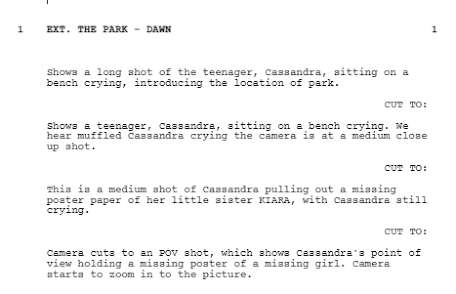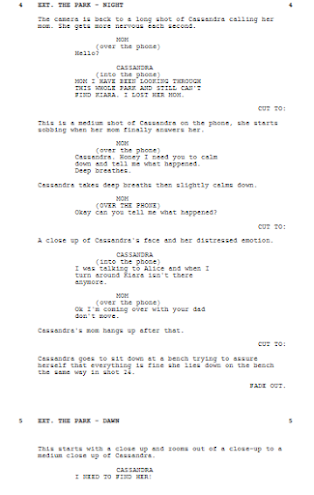Hey, Blog Buddies!
This week in class we are researching the "fun" world of funding, production, distribution, and exhibition. which is a delight for all my classmates, but that begs the question. What is funding? What is production? What is the distribution? What is an exhibition? All of these are critical questions that I will address in my blog post. let us discuss why this is all necessary: funding, production, distribution, and exhibition. These key components all work together as a sequence that starts with funding, production, distribution, and exhibition of the media. First the funding. The funding consists of the film crew garnering money in order to produce the film. Production is used to bring your story together with information such as the casting of actors and, to be more realistic for our opening scene, writing the script. The second stage of producing the film is distribution, releasing and marketing the film to the general population and refining an audience, and the final stage is the exhibition, which entails the screening of the film.
The Big Six
Before we start expanding on the topics listed above, we must discuss the six big production companies dominating the film industry: Paramount Pictures, Universal, 20th Century Fox, Warner Bros, and Pictures Walt Disney and Columbia Pictures. These production companies make up over 80% of the film industry, dominating the indie production companies (an indie company is an independent company; the more successful indie companies are known as mini majors). With the large streams of money these six companies hold, they have a huge influence on funding, production, distribution, and exhibition of smaller scale films. Many productions rely on funding from one of the big six companies by pitching the story line and earning a partnership. If I had to decide whether I would be with a large studio or an indie production company, I would select one of the big 6 companies for freedom within the budget because I know I and my group could notafford over ten dollars for our film budget, and with this budget, we have the potential to create a phenomenal film.
Funding
There are many resources film companies could pull from to fund the film: investors, crowdfunding, or partnering with other companies. Studio Binder recommends crowdfunding for small scale films. Crowdfunding is pitching your story to the internet and users could donate to fund the project. Investing is also another viable option for funding. A person or organization donates money to a film that they feel will produce revenue. Some small film companies choose to partner with one of the big six film companies that fund smaller films, but what do funders receive in return? The investors and companies gain some revenue from the film's production. This is a big incentive for investors, with some of the highest rated films garnering over a hundred thousand dollars in revenue.
Production
There are five vital stages of production development: pre-production, production, post-production, and distribution. I will only be addressing development, pre-production, production, and post-production because distribution deserves it on segmentation. Development is the writing of the scripts, story boarding, and funding. Next is the pre-production stage. This is the beginning of the production process, arranging the dates for filming, the location of the setting, and the general preparations before the filming. Now this is the fun part. The production at this stage includes the filming of the movie. The final stage is post-production, which is the editing of the clips and adding background music. The big six production companies are Paramount Pictures, Universal, 20th Century Fox, Warner Bros, and Pictures. Walt Disney and Columbia Pictures also play a role in the production. So, it is important to get to know the companies. Let us start with Paramount Pictures. Paramount Pictures is known for movies such as Titanic, Transformers, and Shrek. It is worth around three billion USD, with the majority of its movies geared toward young children and teenagers. This is shown with most of their popularity coming from movies such as "Shrek" ($267.67M), "How to Train Your Dragon" ($217.58M) and "Forrest Grump" ($330.25M). Universal is a production company worth six billion and directed toward older teens, as shown by some of their top movies being "Jurassic Park," grossing over $654 million, "Furious 7" ($353.01M) and "The Fate and the Furious" ($226.01M). 20th Century Fox is another production company worth over 71 million and has produced popular movies such as "Avatar" ($237M), "X-Men" ($296.3M) and "Deadpool" ($782M) with the theme of sci-fi movies that pander to older teens. Next is Warner Bros, worth $9.3 billion. They produced movies such as "Suicide Squad" ($55M), "The Batman" ($251M) and "Joker" ($1B) with a clear theme of action and thrillers aimed towards young adults and older teens. Perhaps Warner Bros would be ideal to produce my film, with Warner Bros specializing in thrillers similar to the movie me and my group are trying to create. With Warner Bros. partnering with my film, their audience of young adults and older teens would engage with my film and would enjoy "Gone," a thriller, but if I were to partner with Paramount Pictures, with a younger audience, they would not receive this movie well. I would sell my film as a classic kidnapping with an innovative twist of the best friend, Alice, being the kidnapper with no happy ending. Next, Walt Disney is worth $93 billion and has an audience of primarily children, shown with movies such as "Encanto" ($233.9M) or "Zootopia" ($1B). And last but not least, Columbia Pictures, with movies such as "Ghostbusters" ($295.2), "Venom" ($856.1M), and "Spider-Man 3" ($894.9M), caters to an older teen audience with dark action/thriller themes. All these movie companies are successful in making a huge return, as you can see at the box-office in the films above. For example, the budget for "Shrek" was 60 million USD and made a box-office of $267.67 million, which was a huge success for Paramount Pictures.
Distribution
The distribution of movies is making them available to an audience. Companies such as Netflix, Hulu, and Amazon Prime are distribution companies that could distribute movies to members who pay a subscription. But the production companies, such as the big sic, do their own distribution. I would distribute my film on Netflix. Netflix is a popular subscription streaming service that has over 221.8 million subscribers. According to PGMag, thrillers have some of the most binge-worthy movies, which makes our film able to thrive on Netflix.
There are many ways to watch films, such as streaming services, DVDs, or theaters. This is an exhibition! Many film companies choose to premiere their films in theaters in order to generate excitement around the film, whereas others choose to release their films on streaming services such as Disney+ so that you can watch the movie in the comfort of your own home, which, due to the recent pandemic, is the only option for releasing movies. If my movie was to be exhibited, I would select an online streaming service to make it more accessible to my audience.
Hustle, Indie Film. “Understanding the 5 Stages of Indie Film Production - Indie Film Hustle.” Indie Film Hustle®, 13 Dec. 2021, https://indiefilmhustle.com/5-stages-indie-film-production/#:~:text=Film%20Production%20is%20created%20in,different%20roles%20suit%20different%20stages.
Katie. “Film Production: The Seven Stages of Film Production.” IFilmThings, 21 Jan. 2021, https://ifilmthings.com/stages-of-film-production/#:~:text=The%20seven%20stages%20of%20film%20production%20are%20script%20development%2C%20budgeting,%2C%20and%20post%2Dproduction%20stages.].
Moscaritolo, Angela. “Netflix 'Binge Scale' Ranks Most Addictive Shows, Genres.” PCMAG, PCMag, 9 June 2016, https://www.pcmag.com/news/netflix-binge-scale-ranks-most-addictive-shows-genres.
Paramount Pictures, https://www.paramount.com/.
“Ratings, Reviews, and Where to Watch the Best Movies & TV Shows.” IMDb, IMDb.com, https://www.imdb.com/.
Shorr, Arnon, et al. “The 5 Stages of Video Production.” StudioBinder, 26 Jan. 2021, https://www.studiobinder.com/blog/how-to-make-a-movie/.














